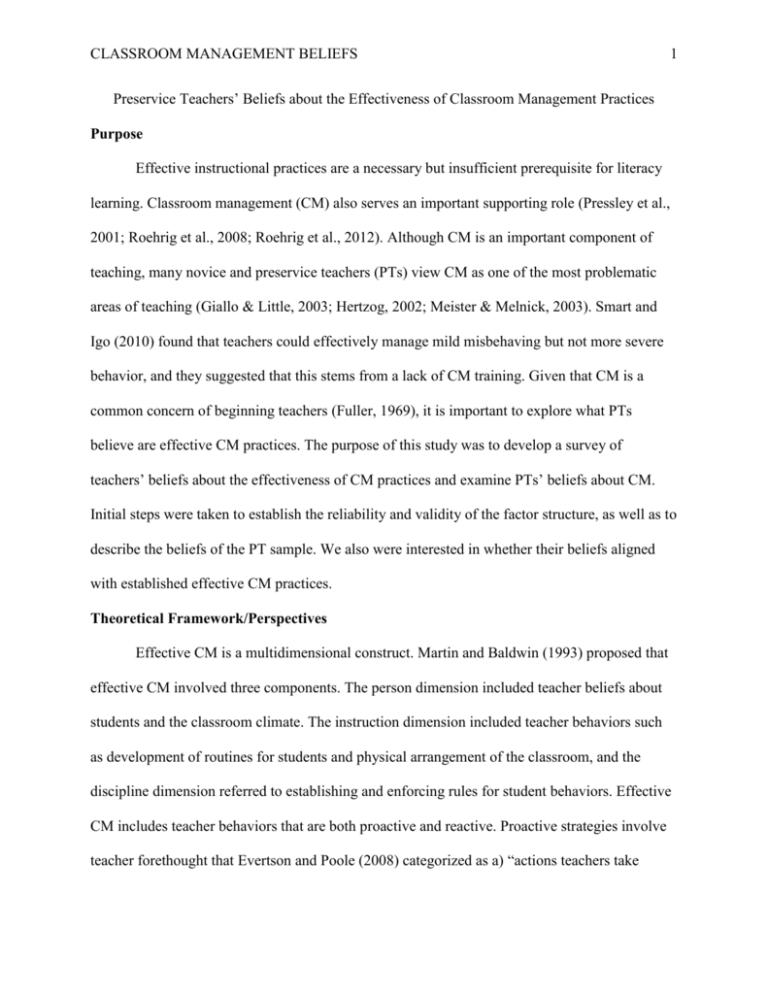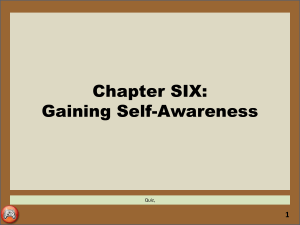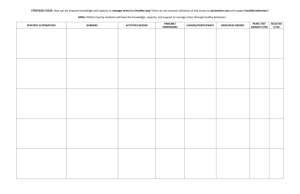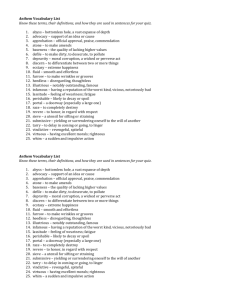CLASSROOM MANAGEMENT BELIEFS Preservice Teachers
advertisement

CLASSROOM MANAGEMENT BELIEFS 1 Preservice Teachers’ Beliefs about the Effectiveness of Classroom Management Practices Purpose Effective instructional practices are a necessary but insufficient prerequisite for literacy learning. Classroom management (CM) also serves an important supporting role (Pressley et al., 2001; Roehrig et al., 2008; Roehrig et al., 2012). Although CM is an important component of teaching, many novice and preservice teachers (PTs) view CM as one of the most problematic areas of teaching (Giallo & Little, 2003; Hertzog, 2002; Meister & Melnick, 2003). Smart and Igo (2010) found that teachers could effectively manage mild misbehaving but not more severe behavior, and they suggested that this stems from a lack of CM training. Given that CM is a common concern of beginning teachers (Fuller, 1969), it is important to explore what PTs believe are effective CM practices. The purpose of this study was to develop a survey of teachers’ beliefs about the effectiveness of CM practices and examine PTs’ beliefs about CM. Initial steps were taken to establish the reliability and validity of the factor structure, as well as to describe the beliefs of the PT sample. We also were interested in whether their beliefs aligned with established effective CM practices. Theoretical Framework/Perspectives Effective CM is a multidimensional construct. Martin and Baldwin (1993) proposed that effective CM involved three components. The person dimension included teacher beliefs about students and the classroom climate. The instruction dimension included teacher behaviors such as development of routines for students and physical arrangement of the classroom, and the discipline dimension referred to establishing and enforcing rules for student behaviors. Effective CM includes teacher behaviors that are both proactive and reactive. Proactive strategies involve teacher forethought that Evertson and Poole (2008) categorized as a) “actions teachers take CLASSROOM MANAGEMENT BELIEFS 2 before the students’ arrival”, b) “interactions teachers plan once students arrive”, and c) “reactions teachers prepare for when students misbehave” (p.132). In this view, even reactive behaviors may be considered proactive if the teacher planned for them in advance, for instance by accounting for them in classroom rules. Several models of teacher effectiveness include CM as a major component. For example, Roehrig et al. (2012) situated CM within a model including instruction and positive atmosphere. They defined dimensions of effective teaching in areas where the three components overlapped. The dimension of planning and delivering instruction (i.e., CM and instruction) included practices like individualizing student instruction based on assessment data, and building context into activities to increase student engagement. Developing caring classroom communities (CM and classroom atmosphere) included teacher management strategies emphasizing monitoring of student behavior instead of punishing students. There is a substantial body of research demonstrating the effectiveness of different practices or programs for reducing problem behaviors in children (e.g., Bear, 1998; Doyle, 1992; Evertson, Emmer, & Worsham 2006; Good & Brophy, 2003). The What Works Clearinghouse published a practice guide--a research synthesis for a practitioner audience--about reducing behavior problems in elementary schools (Epstein, Atkins, Cullinan, Kutash, & Weaver, 2008). By their standards, strong evidence allows generalizable causal inferences about the effectiveness of interventions for the reduction of negative behavioral outcomes, whereas moderate evidence either supports causal inferences, but lacks generalizability, or vice versa. Their recommendations and evidence ratings appear in Table 1. Recommendations for individual teachers include clearly describing problem behaviors and analyzing the environmental context in order to identify behavioral antecedents, actively CLASSROOM MANAGEMENT BELIEFS 3 changing the learning environment, and teaching new skills to increase positive behaviors and maintain a positive classroom climate (Epstein et al., 2008). Other recommendations required collaboration between teachers and others, such as utilizing relationships with colleagues and students' families to address behavior problems, or diagnosing schoolwide behavior problems in order to enact strategies at the school level. For our survey we focused on practices teachers might implement in their classrooms. Previous research on teacher beliefs about CM focused on self-efficacy. According to Bandura (1982), “perceived self-efficacy is concerned with judgments of how well one can execute courses of action required to deal with prospective situations” (p. 122). For teachers, this concept relates to how well they believe they can handle various situations within a school context. Reupert and Woodcock (2010) found that PTs perceived themselves as equally proficient in preventative and initial corrective strategies, but favored initial corrective strategies over preventative, reward and later corrective strategies. PTs often have high self-efficacy beliefs during training that decline after their first year of teaching (Hoy & Spero, 2005), suggesting that self-efficacy beliefs are not always indicative of performance. Given that teachers are likely to use strategies aligned with their self-reported beliefs (Clunies-Ross, Little & Kienhuis, 2008), we chose to examine more general beliefs about CM practices rather than beliefs about participants’ own practices or self-efficacy. Methods The survey was developed to comprehensively represent various theoretical and cultural perspectives on CM, regardless of empirical support for practices. The six management styles conceptually represented in the full measure were reward, preventative, punishment/consequence, threat/fear, do nothing, and revengeful. PTs were asked to rate the CLASSROOM MANAGEMENT BELIEFS 4 effectiveness of 96 CM strategies on a five point Likert scale (1=very ineffective, 2=somewhat ineffective, 3=neither ineffective nor effective, 4=somewhat effective, and 5=very effective). The survey was designed with an awareness that self-reports of socially undesirable activities, such as negative CM strategies, are prone to social desirability bias (SDB; Fisher & Dubé, 2005; Miller, 2011; Silvera, Cronley & Neeley, 2007). SDB is defined as the tendency for respondents to over-report positive beliefs or behaviors and under-report negative ones (Silvera et al., 2007). Indirect questioning can reduce SDB by asking participants to think of situations in general, rather than how they apply to the participant (Fisher, 1993; Myung-Soo, 2000; Silvera et al., 2007). We aimed to discover PTs’ beliefs about CM practices by asking them to rate how effective they think the practices are, thus removing the personal element that gives rise to SDB. Open-ended demographic responses (e.g., intended teacher certification) were double coded by independent raters and compared for accuracy; six cases of disagreement were identified and subsequently resolved. Following the exploratory factor analysis (EFA) described in the results, the remaining items were coded with respect to the IES/WWC recommendations for effective management practices (see Table 1; Epstein et al., 2008). Data Sources Our participants included 356 PTs (49 males, 307 females; 93% ages 18-25), who completed the anonymous survey online (through a subject pool) for course credit in teacher education courses at a large southeastern university. The full U.S. PT data set was used to run an EFA; however, our subsequent analyses and interpretations are from a subsample of 135 secondary English or elementary PTs (14 males, 121 females; M age=18 to 25 years; SD=.435). CLASSROOM MANAGEMENT BELIEFS 5 Results An EFA was conducted with 356 PT responses, and all assumptions were met (including KMO=.943). When eigenvalue loadings were greater than 3.0, two factors emerged. We then removed items with loadings less than .30 or that cross-loaded (see Tables 2 and 3 for remaining items). Sixty items loaded onto Factor 1, which included items with both positive and negative loadings. The 36 positive loading items contained negative wording and were reverse coded to make scores interpretable. Factor 1 represents classroom climate strategies, whereas Factor 2 represents behavior management strategies (please see Table 4 for Cronbach results). For the LRA conference we focused on the results of PTs focused on literacy instruction. The results the full sample, and the sub-sample of PT secondary English and elementary teachers (by gender and subject) are presented in Table 4. The PTs’ Factor 1 ratings suggest that they believe classroom climate strategies are effective for managing student behavior. Their Factor 2 ratings suggest that they are uncertain whether the behavior management strategies are even somewhat effective. For example they thought the reward items were somewhat effective, while they were uncertain about the effectiveness of the punishment/consequences items. It is important to note that punishment is not a universally negative technique and sometimes must be used to remove negative behavior (Little & Atkin-Little, 2008). Little and Atkin-Litle (2008) give general criteria for effective punishment: punishments should be selected beforehand and punishment should not be too severe. The general uncertainty of PTs regarding Punishment/Consequences items may reflect this nuanced nature of effective punishment. When coding how items corresponded to IES/WWC recommendations, we did not code items that represented ineffective practices, such as extreme punitive practices. There were 24 effective practices in Factor 1 and 17 effective practices in Factor 2. All of these practices CLASSROOM MANAGEMENT BELIEFS 6 corresponded to recommendations from IES/WWC, with the majority of the practices corresponding to the second and third recommendations. Interest/Connection to Audience As we continue to work toward enhancing the quality of the literacy instruction students receive, we should consider various factors that may contribute to higher literacy rates, such as CM. Our study gives voice to PTs regarding their beliefs about effective CM. Overall, PTs perceived practices related to classroom climate as effective and were less certain about behavior management strategies. Given their beliefs we think that these PTs may be in a strong position to create environments conducive to literacy learning. CLASSROOM MANAGEMENT BELIEFS 7 References Bandura, A. (1982). Self-efficacy mechanism in human agency. American psychologist, 37(2), 122-147. Bear, G. G. (1998). School discipline in the United States: Prevention, correction, and long-term social development. School Psychology Review, 27(1), 14-32. Clunies-Ross, P., Little, E., & Kienhuis, M. (2008). Self-reported and actual use of proactive and reactive classroom management strategies and their relationship with teacher stress and student behaviour. Educational Psychology, 28(6), 693-710. doi: http://dx.doi.org/10.1080/01443410802206700 Doyle, W. (1992). Curriculum and pedagogy. In P. W. Jackson (Ed.), Handbook of research on curriculum (pp. 486–516). New York: Macmillan. Epstein, M., Atkins, M., Cullinan, D., Kutash, K., & Weaver, R. (2008). Reducing behavior problems in the elementary school classroom: A practice guide (NCEE #2008-012). Washington, DC: National Center for Education Evaluation and Regional Assistance, Institute of Education Sciences, U.S. Department of Education. Retrieved from http://ies.ed.gov/ncee/wwc/publications/practiceguides Evertson, C., Emmer, E., & Worsham, M. (2006). Classroom management for elementary teachers (7th Edition). Boston: Allyn & Bacon. Evertson, C. M., & Poole, I. R. (2008, April). Proactive classroom management. Paper presented at the annual meeting of the American Educational Research Association. Atlanta, GA. Fisher, R. J. (1993). Social desirability bias and the validity of indirect questioning. Journal of Consumer Research, 20(2), 303-315. CLASSROOM MANAGEMENT BELIEFS 8 Fisher, R. J., & Dubé, L. (2005). Gender differences in responses to emotional advertising: A social desirability perspective. Journal of Consumer Research, 31(4), 850-858. doi: http://dx.doi.org/10.1086/426621 Fuller, F. F. (1969). Concerns of teachers: A developmental characterization. American Educational Research Journal, 6(2), 207-226. Giallo, R., & Little, E. (2003). Classroom behaviour problems: The relationship between preparedness, classroom experiences, and self-efficacy in graduate and student teachers. Australian Journal of Educational & Developmental Psychology, 3(1), 21-34. Good, T., & Brophy, J. (2003). Looking in classrooms (9th edition). Boston: Allyn Hertzog, H.S. (2002). “When, how, and who do I ask for help?” Novices’ perceptions of problems and assistance. Teacher Education Quarterly, 29 (3), 25-41. Hoy, A. W., & Spero, R. B. (2005). Changes in teacher efficacy during the early years of teaching: A comparison of four measures. Teaching and Teacher Education, 21(4), 343356. Kounin, J. (1970). Discipline and group management in classrooms. New York: Holt, Rinehard, and Winston, Inc. Martin, N.K., & Baldwin, B. (1993, April). Validation of an inventory of classroom management style: Differences between novice and experienced teachers. Paper presented at the Annual Conference of the American Educational Research Association, Atlanta, GA. Meister, D. G., & Melnick, S. A. (2003). National new teacher study: Beginning teachers' concerns. Action in Teacher Education, 24(4), 87-94. Miller, A. L. (2012). Investigating social desirability bias in student self-report surveys. Educational Research Quarterly, 36(1), 30-47. CLASSROOM MANAGEMENT BELIEFS 9 Myung-Soo, J. (2000). Controlling social-desirability bias via method factors of indirect questioning in structural equation models. Psychology & Marketing, 17 (2), 137-148. Pressley, M., Wharton-McDonald, R., Allington, R., Block, C. C., Morrow, L., Tracey, D., . . . Woo, D. (2001). A study of effective first-grade literacy instruction. Scientific Studies of Reading, 5(1), 35-58. Reupert, A., & Woodcock, S. (2010). Success and near misses: Pre-service teachers' use, confidence and success in various classroom management strategies. Teaching and Teacher Education, 26(6), 1261-1268. doi: http://dx.doi.org/10.1016/j.tate.2010.03.003 Roehrig, A. D., Duggar, S. W., Moats, L., Glover, M., & Mincey, B. (2008). When teachers work to use progress monitoring data to inform literacy instruction. Remedial and Special Education, 29(6), 364-382. doi: http://dx.doi.org/10.1177/0741932507314021 Roehrig, A. D., Pressley, M., & Sloup, M. (2001). Reading strategy instruction in regular primary-level classrooms by teachers trained in reading recovery. Reading & Writing Quarterly: Overcoming Learning Difficulties, 17(4), 323-348. doi: http://dx.doi.org/10.1080/105735601317095061 Roehrig, A. D., Turner, J. E., Arrastia, M., Christesen, E., McElhaney, S., & Jakiel, L. (2012). Effective teachers and teaching: Characteristics and practices related to student outcomes. In T. Urdan, S. Graham, M. Royer, & M. Zeidner (Eds.), Educational psychology handbook, Volume 2: Individual differences, cultural variations, and contextual factors in educational psychology (pp. 501-527). Washington DC: American Psychological Association. Silvera, D.H., Cronley M.L., & Neeley, S.M. (2007). When describing others tells us about ourselves: Indirect questioning as a method for identifying social desirability bias. Paper CLASSROOM MANAGEMENT BELIEFS 10 presented at The La Londe Conference in Marketing Communications and Consumer Behavior, La Londe les Maures, France. Smart, J. B., & Igo, L. B. (2010). A grounded theory of behavior management strategy selection, implementation, and perceived effectiveness reported by first-year elementary teachers. The Elementary School Journal, 110(4), 567-584. doi: http://dx.doi.org/10.1086/651196 Wolfgang, C. H., & Glickman, C. D. (1986). Solving discipline problems: Strategies for classroom teachers (Second edition). Newton, MA: Allyn and Bacon. CLASSROOM MANAGEMENT BELIEFS 11 Table 1 What Works Clearinghouse Recommendations for Reducing Problem Behaviors and Accompanying Evidence Recommendation 1. "Identify the specifics of the problem behavior and the conditions that prompt and reinforce it." 2. "Modify the classroom learning environment to decrease problem behavior." Evidence Moderate* Strong Selected Practices clearly describe the problem behavior and possible antecedents record the frequency of the behavior investigate potential antecedents of the behavior 3. "Teach and reinforce new skills to increase appropriate behavior and preserve a positive classroom climate." Strong 4. "Draw on relationships with professional colleagues and students’ families for continued guidance and support." Moderate 5. "Assess whether school wide behavior problems warrant adopting school wide strategies or programs and, if so, implement ones shown to reduce negative and foster positive interactions." Moderate teach rules and classroom routines to create a positive classroom environment, reinforce appropriate behaviors introduce new instructional material by modeling and giving students opportunities to practice identify individual student needs for explicit instruction in desired behavior teach using examples, opportunities for practice, and feedback reinforce positive behavior with consequences and avoid rewarding consequences of negative behavior (i.e., attention) work with teacher peers in school create partnerships with personnel from different community levels: school, district, behavior experts (counselors) elicit participation from parents or other family members in order to increase desired behaviors use a school wide team to address behavior problems at the school level collect data on the frequency, location and duration of major problem behaviors once an intervention has been implemented, continue using data collection to monitor changes in behavior Note. Moderate evidence=high internal validity OR high external validity across studies; Strong evidence=high internal validity AND high external validity across studies; *Evidence mostly comes from single-subject studies of students diagnosed with emotional and behavioral disorders. (Adapted from Epstein et al., 2009, p. 6-7.) CLASSROOM MANAGEMENT BELIEFS 12 Table 2 Factor 1(Classroom Climate) Items, Categories, and Loadings Item Wording Involving students in the development of classroom rules Identifying unwanted behaviors Having high expectations for students’ success Explaining the logical consequences of misbehaving Managing transitions between objectives/subjects efficiently Making decisions about the best seating arrangement in the classroom Explaining the rules to students Managing lessons efficiently Enforcing rules consistently Monitoring students' behavior Demonstrating desirable classroom behaviors Displaying classroom rules Establishing lines of communication with parents Treating students fairly Maintaining students’ motivation during the lesson Making sure students understand the contents of each lesson Giving students clear instructions Clearly communicating expectations Being honest with students Promoting positive attitudes about the school Establishing caring relationships with students Creating a warm classroom environment Providing unexpected reinforcement (e.g., rewards, praise) for positive behavior Thanking students with other students present when they behave well Allowing misbehavior so students can deal with the consequences Using physical/corporal punishment to discipline students Expelling students from school Mocking students who misbehave Falsely accusing students to get back at them Category Preventive Preventive Preventive Preventive Preventive Loading -0.368 -0.392 -0.427 -0.472 -0.518 Preventive -0.552 Preventive Preventive Preventive Preventive Preventive Preventive Preventive Preventive Preventive Preventive -0.564 -0.575 -0.579 -0.585 -0.62 -0.621 -0.624 -0.635 -0.638 -0.649 Preventive Preventive Preventive Preventive Preventive Preventive Reward -0.659 -0.661 -0.669 -0.676 -0.677 -0.707 -0.328 Reward -0.349 Punishment/Consequences 0.501 Punishment/Consequences 0.456 Punishment/Consequences Revengeful Revengeful 0.333 0.798 0.791 CLASSROOM MANAGEMENT BELIEFS Bullying the student who misbehaves Being emotionally unpredictable (e.g., moody) Showing aggressive behaviors towards students Allowing misbehaving students to be bullied Humiliating a misbehaving student while other students are present Using anger to control misbehavior Giving unwanted nicknames to students who misbehave Nitpicking students’ behaviors Implementing discipline rules in an unfair manner Showing no empathy for the problems of misbehaving students Insisting on being right regardless Telling students their misbehavior is related to their character Holding back affection from students who misbehave Taking into account misbehaviors of students while grading Seating the misbehaving student next to someone he/she does not like Intimidating students by using emotional abuse in the classroom Intimidating students by using physical abuse in the classroom Threatening a student who misbehaves with violent epithet (e.g.,“I will break your neck/head”) Belittling a student who shows unwanted behaviors Telling students they are lazy, sloppy, thoughtless, etc. Threatening to use physical/corporal punishment when students misbehave Using sarcastic language toward students when they misbehave Shouting at students when they misbehave Not having rules for students Not discussing students’ disruptive behaviors with them Discounting students’ feelings Tolerating disorder in the classroom Ignoring disagreements between students in the classroom Avoiding discussion with students about classroom 13 Revengeful Revengeful Revengeful Revengeful Revengeful 0.786 0.784 0.741 0.717 0.709 Revengeful Revengeful Revengeful Revengeful Revengeful 0.703 0.687 0.643 0.638 0.632 Revengeful Revengeful 0.566 0.512 Revengeful Revengeful 0.472 0.392 Revengeful 0.38 Threat/Fear 0.785 Threat/Fear 0.769 Threat/Fear 0.736 Threat/Fear Threat/Fear Threat/Fear 0.729 0.692 0.668 Threat/Fear 0.64 Threat/Fear Do Nothing Do Nothing Do Nothing Do Nothing Do Nothing 0.617 0.725 0.673 0.633 0.604 0.588 Do Nothing 0.53 CLASSROOM MANAGEMENT BELIEFS discipline Not contacting the parents of repeatedly disruptive Do Nothing students Ignoring students who misbehave Do Nothing Note. All (36) positive loading items were reverse coded. 14 0.454 0.302 CLASSROOM MANAGEMENT BELIEFS 15 Table 3 Factor 2 (Behavior Management) Items, Categories, and Loadings Item Wording Using an individual behavior modification system involving rewards Rewarding approximations of desired behaviors (i.e., each time a student gets closer to the desired behavior) Providing predictable reinforcement (e.g., rewards, praise) for positive behavior Category Reward Loading 0.446 Reward 0.407 Reward 0.399 Providing frequent reinforcement (e.g., rewards, praise) for positive behavior Reward 0.372 Using a reward system based on whole class behavior Reward 0.361 Giving students rewards for ending bad behavior Threatening to report misbehaving students to their parents Sending a misbehaving student to the principal’s office Giving students busywork when they misbehave Isolating a student when he/she disrupts instruction Having students perform undesirable tasks as a form of punishment Taking away desirable things (e.g., tokens, rewards, class privileges) from misbehaving students Making students apologize for misbehaving Calling parents when students misbehave Giving students extra homework when they misbehave Seating students in desks that are closer to the teacher when they misbehave Sending students who exhibit misbehavior to timeout Reward Threat/Fear 0.343 0.421 Punishment/Consequences Punishment/Consequences Punishment/Consequences Punishment/Consequences 0.46 0.435 0.415 0.378 Punishment/Consequences 0.378 Punishment/Consequences Punishment/Consequences Punishment/Consequences Punishment/Consequences 0.373 0.369 0.356 0.33 Punishment/Consequences 0.319 CLASSROOM MANAGEMENT BELIEFS 16 Table 4 Secondary English and Elementary Preservice Teachers’ Scores for Factors 1 and 2 Factor 1 Full Sample n M SD Cronbach α 356 4.56 0.47 .967 M Factor 2 SD Cronbach α 3.55 0.48 .77 2 .72 7 .956 Secondary 135 4.67 0.37 3.59 0.45 English/Elementary PTs Male PTs 14 4.67 0.15 3.37 0.49 Female PTs 121 4.67 0.39 3.62 0.44 Elementary PTs 90 4.69 0.35 3.66 0.46 Secondary English PTs 42 4.62 0.41 3.47 0.38 Note. A score of 3 indicates PTs believed on average the items were neither ineffective nor effective, a score of 4 indicates somewhat effective, and a score of 5 indicates strategies are very effective.







